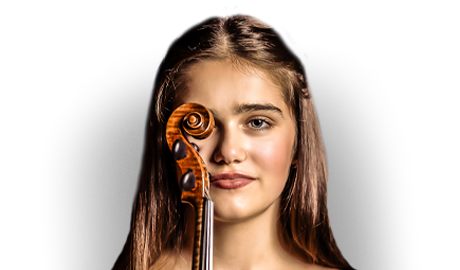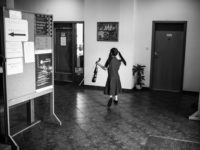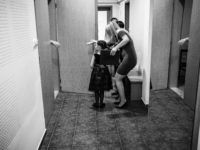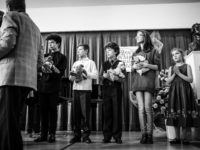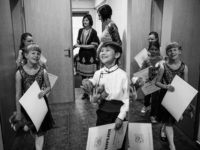Double winner of the Czech Press Photo competition Petr Wagenknecht that last time succeded with photos from the Kocian’s Violin Competition says about himself:
“I am a lover of the exotic in everyday life”
Ústí n. O. – Although wedding photographs are his main domain and last year, the website SLR Lounge classified him as one of the 150 best wedding photographers of the world, a famous photographer from Ústí nad Orlicí Petr Wagenknecht also made his mark in the history of the Kocianovo Ústí. A set of photographs from the Kocian’s Violin Competition, with which he entered the Czech Press Photo competition, won the first place in the Culture and art category. “I was attracted by the backstage, the nervousness was almost sliceable,” he says in the interview that also focuses on his previous engagement in the redaction of the Orlický deník.
In Ústí and not only there, you are known as a great photographer, but as I remember it, your journey to the lens was sort of complicated. Where did it lead you?
Through art. As a child, I painted a lot, I was good at art. Then, I presented my pieces at local exhibitions. When I was twelve and thirteen, I was attracted to the nature, I often went to the plenary. I was oil-painting, which was laborious; therefore, I took photos of the places and painted at home. I did a lot of artistic photos, I entered a local competition with some of them, and won in two categories. Thanks to that, they noticed me in Deník, and when your dad looked for a successor after Rosťa Moravec, he approached me. I am very thankful for that, I did not know much, and he just went for his inner sense. He brought me home some pictures, and I processed them in a bathroom. They were kind of grey. (laughs)
Coming to the newspaper must have been difficult for a young photographer without any experience, right?
I had to learn everything; for example, I had no clue how to do a reportage.
When you look back at the years spent in Orlický deník, what have you learnt?
Firstly, the processing of photographs. In the beginning, we were taking photos on film, we printed them multiple times a day. It was necessary to make the photos bigger in the paper because it was then sent by a train. I was on pins and needles about how it is going to come out the next day. (laughs) But the crafting was beautiful, sweet, full of tension that is lost today. You would come home from the session not knowing how everything is going to turn out.
Did it ever happen that nothing came out right?
Yes. I printed it incorrectly, but I managed to handle it. I came across more trouble with the digital camera. The first one had a memory of 12 snaps, I was taking photos of a cirque in Rychnov, and everything was totally blurry. Another time, I was taking photos at an exhibition of Mr. Koníček in Mýto, and I deleted all my photos.
The advantage of taking photos for a newspaper is that you get to see everything from culture to politics. For instance, sport is extremely important because you improve your reaction and anticipation. You cannot watch the ball, but you must predict, where it is going to land.
You left the redaction back in the 2008. What led you to that? Do you somehow regret it?
In the county, there are logically not many events. Therefore, after taking photos of them for the tenth time, you don’t get much joy from it. I started to focus on my personal projects; I bought some equipment, and I was preparing myself for a change for a couple of years. I went for it in the moment when I was sure I could make a living with photography; without risks. I had some orders planned in advance.
I don’t regret my decision because I like to be my own boss. However, I am not a progressive person. I often have to persuade myself into working. I procrastinate, and I am quite lazy! (laughs)
Is there a big competition in your industry now? I suspect there were some changes in the past years.
I was starting when we were taking photos on film; there were not many photographers. Today the youth must be more talented than I to make a mark; they must be different. I do a lot of wedding photographs, when you look at the basic ones, they are all the same. The trends are copied all the time. Atelier mores are brought to weddings, and portraits are made a lot. I want to bring it back to the natural reportage.
Did you focus on this kind of events from the beginning or did the journey show itself with time?
It absolutely showed itself. As I had peers that were getting married, they sometimes invited me: “Hey, could you bring your camera with you?” I took photos of some events like this, usually on ten films, which is 360 snaps. Today I take about four thousand of them because I do not have to be careful. The wedding photo is done differently, today it is elsewhere. The youth has many interesting ideas, and we have meetings of wedding photographers every year. I crave for the realistic record, without my own influence, I am just an observer. I do not want to put the weeding on a portrait even though I can make it, too. What are one hundred portraits for? In years, you’d rather see how your granddad danced.
Already in the redaction I noticed you bring a little humor into your photographs. How would you call it?
My photos are my reflection, as a positive person I am close to humor, and I am after it. Sometimes I’m successful, sometimes not. At a wedding, I know straight away if it is warm or cold, it is all about relationships. Snapshots usually come themselves, but it still calls for a little anticipation. When the documentarist Jan Špáta was still alive, people said that when he pointed his camera somewhere, something happened. I’m trying to do just that. However, it is true that some situations repeat themselves.
More to the wedding photo, yes, it is easy to make a living of. I usually have reservations at least one year in advance, even more. A lot of photographers only do it for the money. All in all, there is nothing wrong about it; I also make living out of it. Nevertheless, you must realize that the wedding photo is a reportage, not some nice smelling cotton candy. Before I realized this, I did not do the wedding photo with love.
Is there anything that currently complicates your career? Or there is nothing to change, and you are absolutely happy?
Sometimes I have a feeling that I lose sight of the newest technology of processing photos, the youth is more proficient in this. However, I think that I even out this handicap with my experience and conservativeness. I don’t fall for trends. I think that the simplicity of a photo and the classic approach cannot wear out.
You can say that you don’t need to follow the trends with confidence because you make them!
(laughs) A lot of people told me I inspired them to start taking photos.
The readers of the newsletter of the festival and the competition will surely be interested in your success that you achieved with the set of photographs from last year’s Kocian’s Violin Competition in the competition Czech Press Photo. You won the first place in the Culture and arts category. You also won a “gold” in 2013 for the documentation of the Jizerská padesátka. Is there a way to compare these wins?
Jizerská padesátka is a race that lasts several hours, there is a huge amount of people. There are a few thousands of people on a small area. You have a lot of opportunities to find a story. I appreciate both successes, but the Jizerská padesátka was maybe more suitable for me because unlike music, I am interested in sports. At the Kocian’s Violin Competition, I had to wait for the moments, you cannot disturb or annoy people.
What I always say to the boys in the redaction is to “click with heart” because the competitors and their escorts are often sensible about it. Did you somehow adjust your equipment to that?
I have a non-reflex camera that you don’t hear, the closure is electronic, absolutely silent. The camera is inconspicuous, I wasn’t looked at as a “hooded photographer”, but more as a daddy. Only a young organizer by entrance was driving me away all the time because she didn’t know me. (laughs) But everything was agreed on, and I was counting with the fact that the set will be good.
When we talked at the competition last year, you said that you’re only there to watch. But now I understand that you came with the goal to enter the competition with the set of photos. Am I right?
In the first place, I wanted to have nice photos for myself. It is not business, you are absolutely free. The boys in your redaction have just the opposite, I get them, they must work hard, and they are very good.
Did you choose the places to take photos at “Kocianka” by purpose?
You go there where people are. When the children’s orchestra has a rehearsal with Šporcl, something is more likely to happen there. In the auditorium, you see exactly the same as the others. I was attracted by the backstage, the nervousness was almost sliceable. I have a feeling that someone once took photos of it, and Pavel Sedláček told me about it.
From how many photos were you choosing and how did the selection go?
I chose fifty photos from about two thousand. Then I was composing the set in the way that it would make sense. I took out some photos even though they were superior because they did not fit into the whole. The story was the priority, I didn’t care about anything else. I did not have to worry about the technical stuff because I have the setting of the camera handled.
You did not make any significant changes in the postproduction neither?
I don’t edit vigorously. The non-reflex camera has the advantage that you see the exposition straight in the view-finder, you practically cannot mess up anything.
Did you enter the competition purely out of good feeling or did you already have the ambition to win?
I believed in the set, otherwise I wouldn’t enter the competition. The photos are sent until the end of September, and they must be from the recent year. Last year, I sent other two apart from “Kocianka”. I always set the good ones aside. Even the reactions of my friends were very positive. We are used to sharing our work with Radek Kalhous and Vojta Hurych.
So, you are more of colleagues than rivals?
I choose the people that I cooperate with, which comes back to me many times.
And do you participate every year? Is it an obligation among the top photographers?
Not at all, some years I didn’t participate. The results are published in the middle of October. Before, they announced the first three prizes, but now they switched to the system of nominations like at the movie awards. Therefore, you have to go to Prague to know the result.
Well, in that case the journey to Prague last year wasn’t useless…
We were in the same category with my friend Vojta Hurych, we were sitting next to each other. Fortunately, he is much more selfless than me! (laughs) He also won in another category; therefore, it was fine.
Out of nine photos in the set, is there any one that is top, or it only works for you as a whole?
A set must start with a strong photo, and in this case, it is the one in front of the curtain. If I had to choose only one, it would be probably this one. Then I have a favorite, in which a girl with braids is running with a violin. Only later she becomes an interpreter. It is some kind of flowing children’s happiness. Pavel Hůla won’t run around like this! I am a lover of the exotic in everyday life.
And also, lover of the rebellion and insurgency, for example of the young violinists?
Maybe, maybe… Banality in noble environment gets another dimension. A girl crying on the pavement would not have the context of the competition.
So, is it true that the ones who know the mentioned context will appreciate the set more?
But even the jury, photographers, that are not connected to “Kocianka” appreciated it.
This year, it is the jubilee 60th year of the competition, will you be there?
I will be glad to come, but only incognito. I won’t sprawl into your boys’ work because they don’t deserve that a person without responsibility takes their job, I know this well myself.
What about the festival concerts, are you coming to some of them? You’re a representative yourself…
I’d love to see and hear Milenkovič, it’s great that he is coming back to Ústí.
We already came across sports and music. You are popular for your sports performances, with ping pong for instance. What about music?
I think that I can hear a little bit, but I don’t have musical hearing for sure. I don’t even have any determined music taste. When it comes to classical music, I love to listen to Dvořák’s Novosvětská, I feel emotions and nostalgia from Largo. But then for example, I cannot appreciate Janáček from my position of a non-professional.
That makes two of us.
I guess it’s also about the personality of the author. Dvořák seems clear, not complicated and honest to me. It works the same in music as in photos.
I would hate to forget to ask the obligatory “photo question”: Nikon or Canon?
I have Nikon reflex cameras and a non-reflex Fuji camera. I use them based on the type of events. I use the non-reflex camera when I don’t want to be seen, it’s small and it has a retro body. I look like a tourist! (laughs) I used Nikon from the very beginning in the redaction, they had the FM2 there, a legendary machine, well-thumbed, you could possibly lick nuts with it.
Did it ever happen to you that someone kicked you out as intrusive? Would you protect the face or the lens?
A smile usually saves you. Once at a festival in Králíky, some people that were high wanted to pull me down into the mud, but my friend helped me. Some say: “Don’t take photos of me!” and want the exact opposite. When someone is unpleasant, it’s no use trying. At weddings, it usually doesn’t happen because the photographer is welcomed. In newspapers I had some cases with politics, for example during the visit of Miloš Zeman the security prohibited me to take photos when he was smoking in a non-smoking pub. (laughs)

